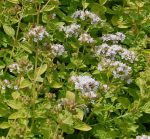 This aromatic perennial herb is native from the Mediterranean to central Asia but has naturalized in the eastern US. It is a member of the mint family, Lamiaceae, that also includes rosemary, beebalm, and lavender. Plants grow 1-2′ tall and have erect, hairy, square stems and oval, pointed leaves up to 2″ long. The tubular, two lipped flowers are 1/4′ long, rose-purple to white, and are carried in terminal spikelets up to 1 1/8 in” long from mid summer to early fall. Oregano is hardy in zones 5-10 and likes full sun, and average, well-drained soil. Propagation is best done by root division in spring or cuttings if the goal is culinary use because seed produces great variability in flavor. The genus name, Origanum, comes from the Greek words oros meaning mountain and ganos meaning joy suggesting their admiration for a plant that grew wild on the mountainsides. The specific epithet, vulgare, is the Latin word meaning common.
This aromatic perennial herb is native from the Mediterranean to central Asia but has naturalized in the eastern US. It is a member of the mint family, Lamiaceae, that also includes rosemary, beebalm, and lavender. Plants grow 1-2′ tall and have erect, hairy, square stems and oval, pointed leaves up to 2″ long. The tubular, two lipped flowers are 1/4′ long, rose-purple to white, and are carried in terminal spikelets up to 1 1/8 in” long from mid summer to early fall. Oregano is hardy in zones 5-10 and likes full sun, and average, well-drained soil. Propagation is best done by root division in spring or cuttings if the goal is culinary use because seed produces great variability in flavor. The genus name, Origanum, comes from the Greek words oros meaning mountain and ganos meaning joy suggesting their admiration for a plant that grew wild on the mountainsides. The specific epithet, vulgare, is the Latin word meaning common.
Although oregano was known from ancient times, the exact species has not been determined but is most probably the one that grew wild on the mountains of Greece, O. vulgare. Both the ancient Greeks and Romans used oregano medicinally as poultices; the Greeks to assuage sores and aching muscles, the Romans to treat scorpion and spider bites. During the Middle Ages oregano was used for a variety of ailments from rheumatism to coughing fits, and in the Elizabethan era it was believed to bring good look and happiness. Oregano was probably used in the colonial times for such problems as coughs, toothaches, baldness, and rheumatism, and may not have been used as a culinary herb until after World War II when American soldiers returned from Europe with a love of the herb in Italian cuisine.